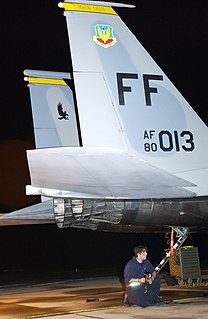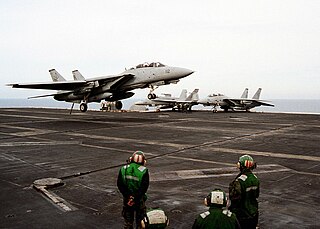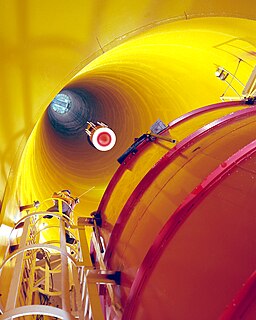Project Pluto was a United States government program to develop nuclear-powered ramjet engines for use in cruise missiles. Two experimental engines were tested at the United States Department of Energy Nevada Test Site (NTS) in 1961 and 1964.

The Surveyor program was a NASA program that, from June 1966 through January 1968, sent seven robotic spacecraft to the surface of the Moon. Its primary goal was to demonstrate the feasibility of soft landings on the Moon. The Surveyor craft were the first American spacecraft to achieve soft landing on an extraterrestrial body. The missions called for the craft to travel directly to the Moon on an impact trajectory, a journey that lasted 63 to 65 hours, and ended with a deceleration of just over three minutes to a soft landing. The program was implemented by NASA's Jet Propulsion Laboratory (JPL) to prepare for the Apollo program. JPL selected Hughes Aircraft to develop the spacecraft system. The total cost of the Surveyor program was officially $469 million.

Luna 8, also known as Lunik 8, was a lunar space probe of the Luna program. It was launched in on December 3, 1965 with the objective of achieving a soft landing on the Moon. However, its retrorocket firing occurred too late, and suffered a hard impact on the lunar surface on the Oceanus Procellarum. The mission did complete the experimental testing of its stellar-guidance system and the ground-control of its radio telemetry equipment, its flight trajectory, and its other instrumentation.

A proximity fuze is a fuze that detonates an explosive device automatically when the distance to the target becomes smaller than a predetermined value. Proximity fuzes are designed for targets such as planes, missiles, ships at sea, and ground forces. They provide a more sophisticated trigger mechanism than the common contact fuze or timed fuze. It is estimated that it increases the lethality by 5 to 10 times, compared to these other fuzes.

Saturn-Apollo 3 (SA-3) was the third flight of the Saturn I launch vehicle, the second flight of Project Highwater, and part of the American Apollo program. The rocket was launched on November 16, 1962, from Cape Canaveral, Florida.

A retrorocket is a rocket engine providing thrust opposing the motion of a vehicle, thereby causing it to decelerate. They have mostly been used in spacecraft, with more limited use in short-runway aircraft landing. New uses are emerging in the 2010s for retro-thrust rockets in reusable launch systems.

A tailhook, arresting hook, or arrester hook is a device attached to the empennage (rear) of some military fixed-wing aircraft. The hook is used to achieve rapid deceleration during routine landings aboard aircraft carrier flight decks at sea, or during emergency landings or aborted takeoffs at properly equipped airports.

The Northrop XP-79, USAAF project number MX-365, was an ambitious design for a flying wing fighter aircraft, designed by Northrop. It had several notable design features; among these, the pilot would operate the aircraft from a lying position, permitting the pilot to withstand much greater g-forces in the upward and downward direction with respect to the plane – and welded magnesium monocoque structure instead of riveted aluminum.

An arresting gear, or arrestor gear, is a mechanical system used to rapidly decelerate an aircraft as it lands. Arresting gear on aircraft carriers is an essential component of naval aviation, and it is most commonly used on CATOBAR and STOBAR aircraft carriers. Similar systems are also found at land-based airfields for expeditionary or emergency use. Typical systems consist of several steel wire ropes laid across the aircraft landing area, designed to be caught by an aircraft's tailhook. During a normal arrestment, the tailhook engages the wire and the aircraft's kinetic energy is transferred to hydraulic damping systems attached below the carrier deck. There are other related systems which use nets to catch aircraft wings or landing gear. These barricade and barrier systems are only used for emergency arrestments for aircraft without operable tailhooks.

Panjandrum, also known as The Great Panjandrum, was a massive, rocket-propelled, explosive-laden cart designed by the British military during World War II. It was one of a number of highly experimental projects, including Hajile and the Hedgehog, that were developed by the Admiralty's Directorate of Miscellaneous Weapons Development (DMWD) in the final years of the war. The Panjandrum was never used in battle.
The earthquake bomb, or seismic bomb, was a concept that was invented by the British aeronautical engineer Barnes Wallis early in World War II and subsequently developed and used during the war against strategic targets in Europe. A seismic bomb differs somewhat in concept from traditional bombs, which usually explode at or near the surface, and destroy their target directly by explosive force. In contrast, a seismic bomb is dropped from high altitude to attain very high speed as it falls and upon impact, penetrates and explodes deep underground, causing massive caverns or craters known as camouflets, as well as intense shockwaves. In this way, the seismic bomb can affect targets that are too massive to be affected by a conventional bomb, as well as damage or destroy difficult targets such as bridges and viaducts.

The Lagonda company produced a number of flamethrowers during the Second World War.

The low-altitude parachute-extraction system (LAPES) is a tactical military airlift delivery method where a fixed wing cargo aircraft can deposit supplies in situations in which landing is not an option, in an area that is too small to accurately parachute supplies from a high altitude.

The Department of Miscellaneous Weapons Development (DMWD), also known as the Directorate of Miscellaneous Weapon Development and colloquially known as the Wheezers and Dodgers, was a department of the Admiralty responsible for the development of various unconventional weapons during World War II.

An aeroshell is a rigid heat-shielded shell that helps decelerate and protects a spacecraft vehicle from pressure, heat, and possible debris created by drag during atmospheric entry. Its main components consist of a heat shield and a back shell. The heat shield absorbs heat caused by air compression in front of the spacecraft during its atmospheric entry. The back shell carries the load being delivered, along with important components such as a parachute, rocket engines, and monitoring electronics like an inertial measurement unit that monitors the orientation of the shell during parachute-slowed descent.

The Zero Gravity Research Facility at the NASA Glenn Research Center in Cleveland, Ohio is a unique facility designed to perform tests in a reduced gravity environment. It has successfully supported research for the United States manned spacecraft programs and numerous unmanned projects. The facility uses vertical drop tests in a vacuum chamber to investigate the behavior of components, systems, liquids, gases, and combustion in such circumstances.

The Disney bomb, also known as the Disney Swish, officially the 4500 lb Concrete Piercing/Rocket Assisted bomb was a rocket-assisted bunker buster bomb developed during the Second World War by the British Royal Navy to penetrate hardened concrete targets, such as submarine pens, which could resist conventional free-fall bombs. Devised by Royal Navy Captain Edward Terrell, the bomb was fitted with solid-fuel rockets to accelerate its descent, giving it an impact speed of 990 mph (1,590 km/h) — substantially beyond the 750 mph (1,210 km/h) free-fall impact velocity of the 5 tonne Tallboy "earthquake" bomb for comparable purposes. The Disney could penetrate 16 ft (4.9 m) of solid concrete before detonating. The name is attributed to a propaganda film produced by the Walt Disney Studios, that provided the inspiration for the design.
A contact fuze, impact fuze, percussion fuze or direct-action (D.A.) fuze (UK) is the fuze that is placed in the nose of a bomb or shell so that it will detonate on contact with a hard surface.

The SpaceX reusable launch system development program is a privately funded program to develop a set of new technologies for an orbital launch system that may be reused many times in a manner similar to the reusability of aircraft. The company SpaceX is developing the technologies over a number of years to facilitate full and rapid reusability of space launch vehicles. The project's long-term objectives include returning a launch vehicle first stage to the launch site in minutes and to return a second stage to the launch pad following orbital realignment with the launch site and atmospheric reentry in up to 24 hours. SpaceX's long term goal is that both stages of their orbital launch vehicle will be designed to allow reuse a few hours after return.

The Falcon 9 first-stage landing tests were a series of controlled-descent flight tests conducted by SpaceX between 2013 and 2016. Since 2017, the first stage of Falcon 9 missions has been routinely landed if the rocket performance allowed it, and if SpaceX chose to recover the stage.


























